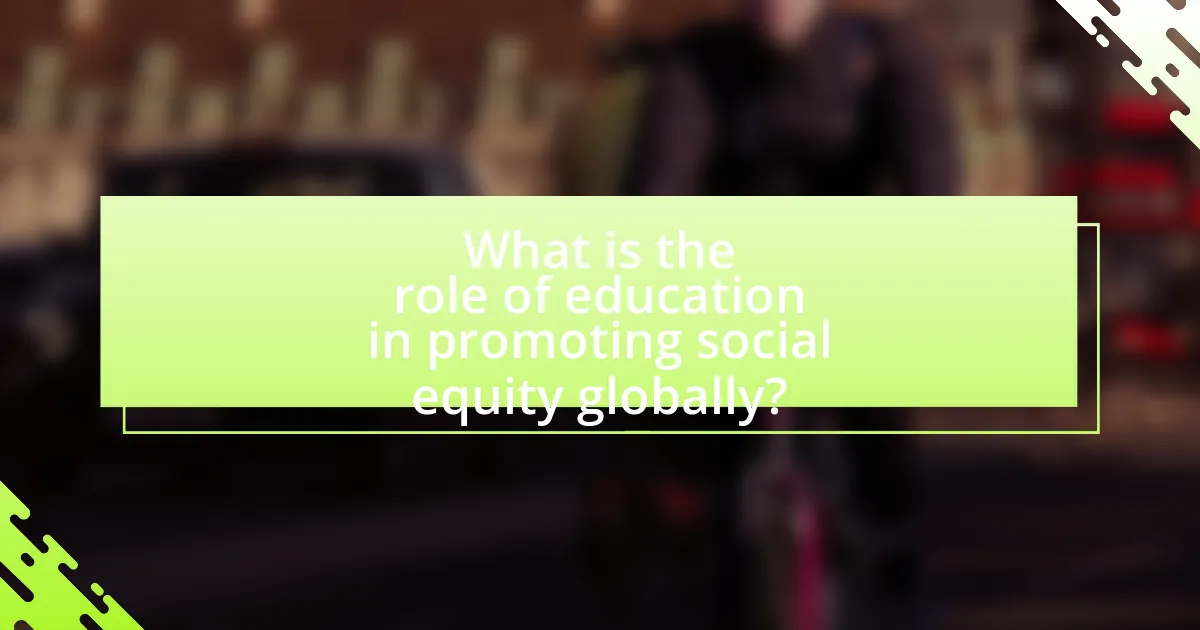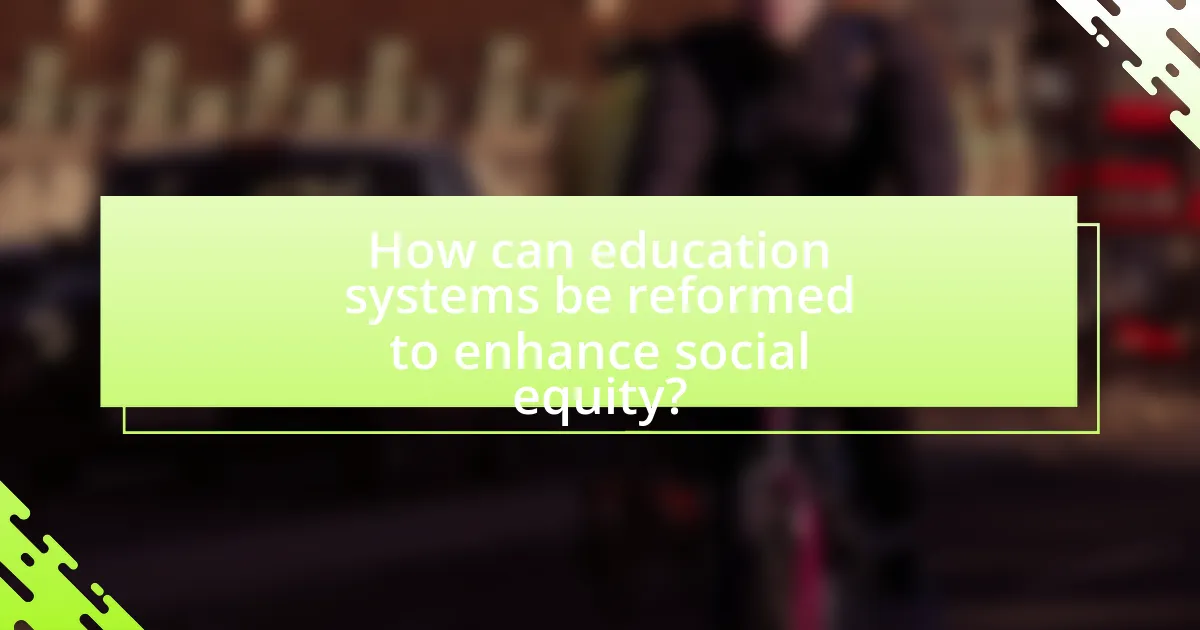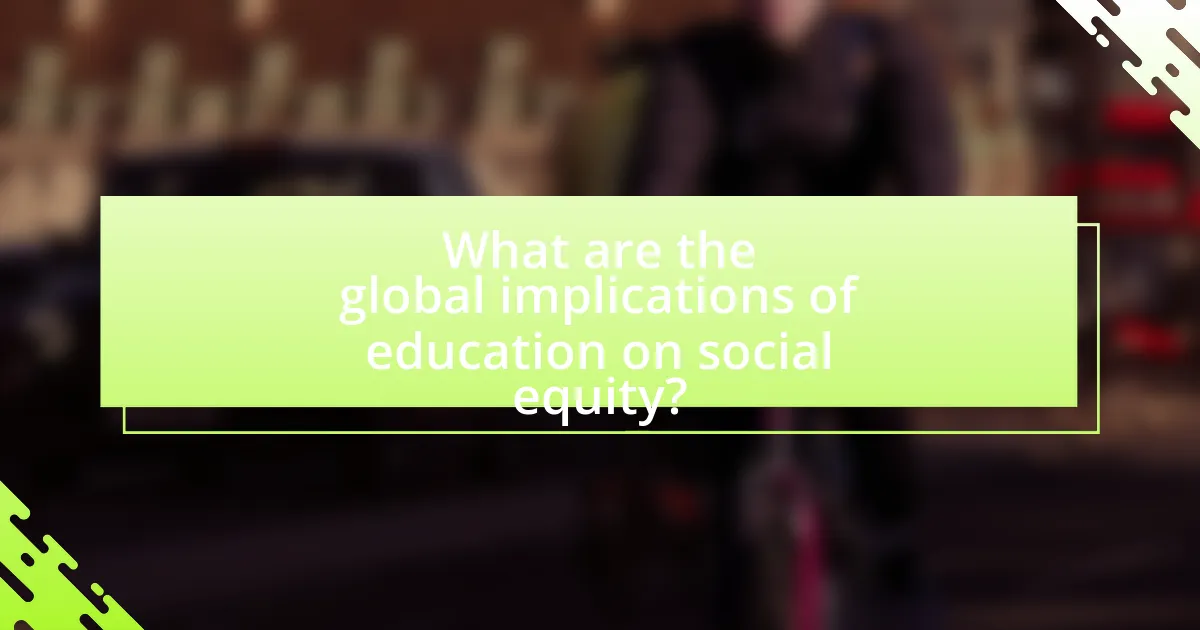The article examines the critical role of education in promoting social equity on a global scale. It highlights how access to quality education can reduce disparities in income, health, and opportunities, particularly for marginalized groups. Key principles of social equity in education, such as access, participation, and outcome equity, are discussed alongside the challenges faced in achieving these goals, including systemic inequalities and resource disparities. The article also explores the impact of cultural perceptions, funding models, and community programs on educational equity, while emphasizing the importance of international frameworks and policies that support education as a fundamental right. Additionally, it outlines practical steps individuals can take to advocate for educational equity, underscoring the transformative power of education in fostering inclusive societies.

What is the role of education in promoting social equity globally?
Education plays a crucial role in promoting social equity globally by providing individuals with the knowledge and skills necessary to improve their socio-economic status. Access to quality education reduces disparities in income, health, and opportunities, enabling marginalized groups to participate fully in society. For instance, UNESCO reports that each additional year of schooling can increase an individual’s income by up to 10%, highlighting the economic benefits of education. Furthermore, education fosters critical thinking and civic engagement, empowering individuals to advocate for their rights and challenge systemic inequalities. This transformative power of education is essential for building inclusive societies and achieving the United Nations’ Sustainable Development Goal 4, which aims to ensure inclusive and equitable quality education for all.
How does education contribute to social equity?
Education contributes to social equity by providing individuals with the knowledge and skills necessary to access better economic opportunities and participate fully in society. It reduces disparities in income and employment by equipping marginalized groups with qualifications that enhance their employability. For instance, research from the Organisation for Economic Co-operation and Development (OECD) indicates that individuals with higher education levels earn significantly more over their lifetimes compared to those with lower educational attainment, thereby narrowing income gaps. Additionally, education fosters critical thinking and civic engagement, empowering individuals to advocate for their rights and influence policy decisions that affect their communities. This empowerment is crucial for addressing systemic inequalities and promoting a more equitable society.
What are the key principles of social equity in education?
The key principles of social equity in education include access, participation, and outcome equity. Access equity ensures that all students have equal opportunities to enroll in educational institutions, regardless of their socioeconomic status, race, or geographic location. Participation equity focuses on creating inclusive environments where all students can engage fully in the educational process, which includes addressing barriers that marginalized groups may face. Outcome equity emphasizes that all students should achieve similar educational results, highlighting the need for tailored support and resources to meet diverse needs. These principles are supported by research indicating that equitable educational practices lead to improved academic performance and social mobility for disadvantaged populations.
How does access to education impact social equity?
Access to education significantly enhances social equity by providing individuals from diverse backgrounds with equal opportunities for personal and professional development. When education is accessible, it reduces disparities in income, employment, and social mobility, allowing marginalized groups to improve their socioeconomic status. For instance, UNESCO reports that each additional year of schooling can increase an individual’s income by up to 10%, demonstrating a direct correlation between education access and economic equity. Furthermore, education fosters critical thinking and civic engagement, empowering individuals to advocate for their rights and participate in democratic processes, which further promotes social equity.
Why is education considered a fundamental right?
Education is considered a fundamental right because it is essential for the exercise of other human rights and for the development of individuals and societies. The Universal Declaration of Human Rights, adopted by the United Nations in 1948, explicitly states in Article 26 that everyone has the right to education, which underscores its universal importance. Access to education promotes equality, empowers individuals, and fosters social and economic development, making it a cornerstone for achieving social equity globally. Studies show that education reduces poverty and inequality, as educated individuals are more likely to participate in the workforce and contribute to their communities.
What international frameworks support education as a right?
International frameworks that support education as a right include the Universal Declaration of Human Rights (UDHR), the International Covenant on Economic, Social and Cultural Rights (ICESCR), and the Convention on the Rights of the Child (CRC). The UDHR, adopted in 1948, explicitly states in Article 26 that everyone has the right to education. The ICESCR, which came into force in 1976, further emphasizes this right in Article 13, mandating that education should be accessible to all. Additionally, the CRC, adopted in 1989, asserts in Article 28 that children have the right to education, highlighting the importance of making primary education compulsory and available free to all. These frameworks collectively establish a global consensus on the fundamental nature of education as a human right.
How do cultural perceptions of education influence social equity?
Cultural perceptions of education significantly influence social equity by shaping access to educational resources and opportunities. Societies that value education as a fundamental right tend to invest more in public education systems, leading to equitable access for all socioeconomic groups. For instance, countries like Finland, which prioritize education, exhibit lower levels of inequality in educational attainment compared to nations where education is viewed as a privilege. Research indicates that in cultures where education is associated with social mobility, individuals from disadvantaged backgrounds are more likely to pursue higher education, thereby reducing social disparities. Conversely, in cultures that stigmatize certain educational paths or prioritize elite institutions, marginalized groups often face barriers that perpetuate inequality.
What challenges does education face in promoting social equity?
Education faces significant challenges in promoting social equity, primarily due to systemic inequalities, resource disparities, and cultural biases. Systemic inequalities manifest in the form of unequal access to quality education based on socioeconomic status, race, and geographic location, which perpetuates cycles of poverty and disadvantage. Resource disparities are evident in funding allocations, where schools in affluent areas receive more financial support compared to those in low-income neighborhoods, leading to differences in educational quality and opportunities. Cultural biases also hinder social equity, as curricula may not reflect the diverse backgrounds of all students, resulting in alienation and disengagement from the educational process. These challenges collectively impede the ability of education systems to foster an equitable environment for all learners.
What are the barriers to accessing quality education?
Barriers to accessing quality education include socioeconomic status, geographic location, and systemic discrimination. Socioeconomic status affects families’ ability to afford educational resources, leading to disparities in access. Geographic location, particularly in rural or underserved urban areas, often results in limited school availability and inadequate infrastructure. Systemic discrimination based on race, gender, or disability further exacerbates these issues, as marginalized groups frequently face additional obstacles in enrollment and retention. According to UNESCO, over 260 million children and youth are out of school globally, highlighting the significant impact of these barriers on educational equity.
How do socioeconomic factors affect educational opportunities?
Socioeconomic factors significantly affect educational opportunities by influencing access to resources, quality of education, and support systems. Families with higher income levels can afford better educational resources, such as tutoring, extracurricular activities, and advanced technology, which enhance learning outcomes. For instance, a study by the National Center for Education Statistics found that students from low-income families are less likely to have access to high-quality schools and experienced teachers, leading to disparities in educational attainment. Additionally, socioeconomic status impacts parental involvement in education, as parents with more education and financial stability are often more engaged in their children’s schooling, further contributing to the educational gap.

How can education systems be reformed to enhance social equity?
Education systems can be reformed to enhance social equity by implementing policies that ensure equal access to quality education for all students, regardless of their socioeconomic background. This can be achieved through increased funding for under-resourced schools, which often serve marginalized communities, thereby addressing disparities in educational opportunities. For instance, research from the National Center for Education Statistics indicates that schools in low-income areas receive significantly less funding than those in affluent neighborhoods, leading to unequal educational outcomes. Additionally, integrating culturally relevant curricula and providing support services, such as counseling and mentorship programs, can help address the unique challenges faced by disadvantaged students. These reforms are essential for creating an equitable educational landscape that promotes social mobility and reduces systemic inequalities.
What strategies can be implemented to improve educational access?
To improve educational access, strategies such as increasing funding for schools in underserved areas, implementing technology-based learning solutions, and providing transportation assistance can be effective. Increased funding allows for better resources, teacher training, and infrastructure improvements, which are essential for quality education. For instance, a study by the National Center for Education Statistics indicates that schools with higher funding levels tend to have better student outcomes. Technology-based learning solutions, such as online courses and digital resources, can bridge gaps for students in remote or low-income areas, as evidenced by the success of programs like Khan Academy, which offers free educational resources globally. Additionally, providing transportation assistance ensures that students can reach schools, particularly in rural areas where distances may be prohibitive. These strategies collectively enhance educational access and promote social equity.
How can technology be leveraged to bridge educational gaps?
Technology can be leveraged to bridge educational gaps by providing access to quality learning resources and facilitating personalized learning experiences. Online platforms, such as Khan Academy and Coursera, offer free or low-cost courses that reach underserved populations, enabling them to learn at their own pace. According to a report by the World Bank, digital learning tools can improve educational outcomes, particularly in remote areas where traditional educational resources are limited. Additionally, adaptive learning technologies use data analytics to tailor educational content to individual student needs, enhancing engagement and comprehension. This approach has been shown to increase student performance, as evidenced by studies indicating that personalized learning can lead to significant gains in academic achievement.
What role do community programs play in supporting education?
Community programs play a crucial role in supporting education by providing resources, mentorship, and engagement opportunities that enhance learning experiences. These programs often address gaps in educational access and quality, particularly in underserved communities. For instance, research from the National Center for Education Statistics indicates that community-based initiatives can improve student achievement by offering tutoring, after-school activities, and parental involvement strategies. Such programs foster a supportive environment that encourages academic success and social development, ultimately contributing to greater social equity.
How can curricula be designed to promote inclusivity?
Curricula can be designed to promote inclusivity by integrating diverse perspectives, ensuring representation of various cultures, and accommodating different learning styles. This approach fosters an environment where all students feel valued and engaged. Research indicates that inclusive curricula lead to improved academic outcomes and social cohesion, as evidenced by a study from the National Center for Education Statistics, which found that schools implementing inclusive practices saw a 20% increase in student engagement. Additionally, incorporating universal design for learning principles allows educators to tailor instruction to meet the varied needs of learners, further enhancing inclusivity.
What are the benefits of culturally relevant pedagogy?
Culturally relevant pedagogy enhances student engagement and academic achievement by connecting educational content to students’ cultural backgrounds. This approach fosters a sense of belonging and validation among diverse learners, which can lead to improved motivation and participation in the classroom. Research indicates that when students see their cultures reflected in the curriculum, they are more likely to excel academically; for instance, a study by Ladson-Billings (1994) found that culturally relevant teaching practices significantly improved the performance of African American students. Additionally, culturally relevant pedagogy promotes critical thinking and social awareness, equipping students with the skills to navigate and challenge societal inequities.
How can educators be trained to address equity issues?
Educators can be trained to address equity issues through comprehensive professional development programs that focus on culturally responsive teaching, implicit bias training, and inclusive curriculum design. These programs equip educators with the knowledge and skills necessary to recognize and mitigate disparities in educational access and outcomes. Research indicates that culturally responsive teaching improves student engagement and achievement, particularly among marginalized groups, as highlighted in the work of Ladson-Billings (1994) in “The Dreamkeepers: Successful Teachers of African American Children.” Additionally, training that includes data analysis on student performance can help educators identify inequities and implement targeted interventions.
What policies can governments adopt to support equitable education?
Governments can adopt policies such as increasing funding for under-resourced schools, implementing universal access to early childhood education, and establishing equitable school funding formulas to support equitable education. Increased funding for under-resourced schools can help provide necessary resources and qualified teachers, which is crucial for student success. Universal access to early childhood education ensures that all children, regardless of socioeconomic status, have a strong foundation for learning. Equitable school funding formulas can address disparities by allocating resources based on student needs rather than local property taxes, which often favor wealthier districts. These policies have been shown to improve educational outcomes and reduce achievement gaps, as evidenced by studies indicating that equitable funding leads to better performance in disadvantaged communities.
How do funding models impact educational equity?
Funding models significantly impact educational equity by determining the distribution of financial resources among schools, which directly affects access to quality education. For instance, models that rely heavily on local property taxes often result in disparities, as wealthier areas can allocate more funds to their schools compared to lower-income regions. According to the U.S. Department of Education, schools in low-income neighborhoods receive about 15% less funding than those in affluent areas, leading to inequitable access to educational resources, experienced teachers, and advanced coursework. This funding gap perpetuates systemic inequalities, limiting opportunities for students from disadvantaged backgrounds and hindering their academic and social mobility.
What role does public-private partnership play in education reform?
Public-private partnerships (PPPs) play a crucial role in education reform by leveraging resources, expertise, and innovation from both sectors to improve educational outcomes. These collaborations can enhance infrastructure, provide funding, and introduce new teaching methodologies, which are essential for addressing educational disparities. For instance, a report by the World Bank highlights that PPPs can increase access to quality education, particularly in underserved areas, by mobilizing private investment and expertise to complement public efforts. This synergy not only improves the quality of education but also fosters accountability and efficiency in the education system, ultimately contributing to social equity on a global scale.

What are the global implications of education on social equity?
Education significantly influences social equity on a global scale by providing individuals with the skills and knowledge necessary to improve their socio-economic status. Access to quality education reduces disparities in income and employment opportunities, fostering a more equitable society. For instance, UNESCO reports that each additional year of schooling can increase a person’s income by up to 10%, highlighting the economic benefits of education. Furthermore, education promotes social mobility, enabling marginalized groups to break the cycle of poverty and contribute to economic growth. Studies show that countries with higher education levels tend to have lower income inequality, reinforcing the link between education and social equity.
How does education influence economic development in societies?
Education significantly influences economic development in societies by enhancing human capital, which leads to increased productivity and innovation. A well-educated workforce is more capable of adapting to new technologies and processes, thereby driving economic growth. For instance, countries with higher literacy rates and educational attainment, such as Finland and South Korea, have experienced substantial economic advancements, evidenced by their high GDP per capita and competitive global markets. Furthermore, the World Bank reports that each additional year of schooling can increase an individual’s income by up to 10%, illustrating the direct correlation between education and economic prosperity.
What is the relationship between education and poverty reduction?
Education significantly contributes to poverty reduction by enhancing individuals’ skills and employability, leading to better job opportunities and higher income levels. Studies show that each additional year of schooling can increase a person’s earnings by approximately 10%. Furthermore, educated individuals are more likely to participate in the labor market and less likely to rely on social welfare programs. For instance, the World Bank reports that education can lift entire families out of poverty, as educated parents are more likely to invest in their children’s education, creating a cycle of opportunity and economic stability.
How does educated workforce contribute to national growth?
An educated workforce contributes to national growth by enhancing productivity and innovation. Higher education levels lead to a more skilled labor force, which increases efficiency in various sectors. For instance, countries with a higher percentage of college graduates, such as the United States, experience greater economic output; research indicates that a 1% increase in the share of college-educated workers can boost GDP by approximately 0.5%. Additionally, educated individuals are more likely to engage in entrepreneurial activities, driving job creation and economic diversification. This correlation between education and economic performance is supported by data from the OECD, which shows that countries investing in education see improved economic resilience and growth rates.
What examples exist of successful education initiatives promoting equity?
Successful education initiatives promoting equity include the “Teach For All” network, which operates in over 50 countries and recruits high-achieving individuals to teach in underserved communities, thereby addressing educational disparities. Another example is the “Equity in Education” program by the World Bank, which focuses on improving access to quality education for marginalized groups, evidenced by increased enrollment rates in targeted regions. Additionally, the “Success for All” program in the United States has shown significant improvements in literacy and academic achievement among low-income students, demonstrating effective strategies for equitable education.
What lessons can be learned from countries with high educational equity?
Countries with high educational equity demonstrate that inclusive policies and targeted investments in education can significantly reduce disparities in learning outcomes. For instance, Finland’s education system emphasizes equal access to quality education for all students, regardless of socioeconomic background, resulting in consistently high performance in international assessments like PISA. Additionally, countries such as Canada and Singapore implement comprehensive support systems, including early childhood education and ongoing teacher training, which contribute to equitable educational opportunities. These examples illustrate that prioritizing educational equity leads to improved social mobility and overall societal well-being.
How do international organizations support educational equity initiatives?
International organizations support educational equity initiatives by providing funding, resources, and expertise to improve access to quality education for marginalized groups. For example, UNESCO’s Global Education Monitoring Report highlights the importance of inclusive education policies and practices, emphasizing that equitable access to education can reduce social disparities. Additionally, organizations like UNICEF implement programs that target vulnerable populations, such as girls and children with disabilities, ensuring they receive the necessary support to succeed in education. These efforts are backed by data showing that increased investment in education leads to better economic outcomes and social cohesion, reinforcing the critical role of education in promoting social equity globally.
What practical steps can individuals take to advocate for educational equity?
Individuals can advocate for educational equity by actively participating in local school boards and community meetings to influence policy decisions. Engaging in these platforms allows individuals to voice concerns about disparities in funding and resources, which are critical for equitable education. Research indicates that schools in low-income areas receive significantly less funding, impacting the quality of education provided (U.S. Department of Education, 2019). Additionally, individuals can support organizations that focus on educational equity, such as Teach For America or the Education Trust, which work to address systemic inequalities. Volunteering time or resources to tutoring programs in underserved communities also directly contributes to leveling the educational playing field. By taking these steps, individuals can play a vital role in promoting educational equity and ensuring that all students have access to quality education.
